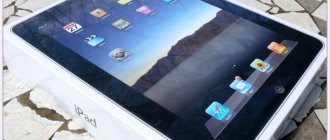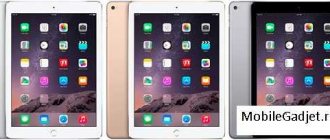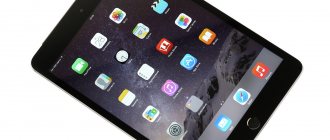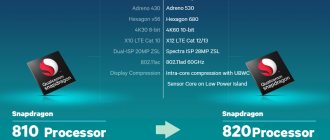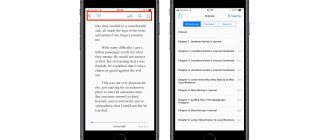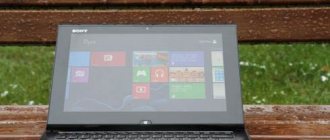Apple's first autumn presentation was dedicated to the new Apple Watch and iPad. Tablets within its framework were presented by the inexpensive iPad 8th generation, as well as the mid-budget iPad Air 4th generation. In this material we will focus on the latter, which turned out to be extremely interesting.
The big question to answer is: how does the fresh 4th generation iPad Air differ from the still peppy 3rd generation iPad Air?
Already from the first frames of the presented gadget, it is clear that there are plenty of differences . It remains to decide whether they are worth running to the store for a new product.
Design
It’s very interesting how the new colors of the case will look in person, because in the photos they seem very fresh and interesting.
Of course, the main visible innovation of the 4th generation iPad Air was the design of the case. We won’t be mistaken if we call the previous iPad Air 3rd generation classic , because even the iPad 2 can be considered a prototype for it. No, this is an objective reality, not a stupid joke.
Last year's model of the “airy” tablet was distinguished by frames around the screen of an impressive size in white or black, a traditional “Home” button with a Touch ID scanner under the display, as well as smoothed side edges of the rear part made of aluminum. This form was left today for the 8th generation iPad.
Personally, I would take either the classic silver one or the “Blue Sky” option.
The new design is closer to the current iPad Pro line , which was obviously inspired by the angular iPhone 5 and iPhone 5s. On the front side of the gadget there are noticeably narrower frames around the screen, which can only be black. The lateral edges are pronounced, they have a chopped shape.
In addition to the design, the next generation of iPad Air received two new colors in which aluminum can be painted using anodizing. Along with silver, “space gray” and “rose gold” were green and “blue sky”.
Apparently, similar options should be expected in the iPhone 12 line.
Dimensions and weight:
- iPad Air 3rd generation: 250.6 x 174.1 x 6.1 mm, 456 g (464 g with cellular version)
- iPad Air 4th generation: 247.6 x 178.5 x 6.1 mm, 458 g (460 g with cellular version)
The main differences between gadgets in terms of size and weight are length and width. The new product has decreased in length and increased in width. However, the differences are not large enough to be taken into account. If the 3rd generation iPad Air's form factor suits you, the 4th generation won't disappoint.
iPad 3
A new model was released in 2012.
What's better:
increased display sharpness;
powerful battery;
built-in Retina protective glass;
improved camera.
The design changes affected only the lens itself (its dimensions). It could be used to distinguish the third generation of iPad.
The iPad 3 added support for 4G networks. At that time, this function was more useless than in demand, since fourth generation networks were not widespread.
Technical indicators:
- display: 9.7, resolution – 1536x2048 pixels, Retina protective glass;
- processor: two cores at 890 megahertz;
- camera: 5 and 0.3 megapixels;
- memory: 1 gigabyte of RAM, 16-64 gigabytes of internal memory.
Display
So you can’t immediately tell which gadget you’re looking at right now: the 4th generation iPad Air or the 11-inch iPad Pro model
Of course, any modern mobile device is built around the screen, to which engineers adjust the design and other structural elements. You need to start with the fact that instead of the sharp corners of the 3rd generation iPad Air, the display in the new product has rounded ones. The size has increased slightly.
Size, resolution and density:
- iPad Air 3rd generation: 10.5 inches, 2224x1668 pixels, 264 PPI
- iPad Air 4th generation: 10.9 inches, 2360x1640 pixels, 264 PPI
As we can see, the density has traditionally remained unchanged: individual points with such PPI values, if they can be seen, are only at an extremely close distance. The resolution changed slightly in favor of the minimum aspect ratio, which in the end still remained in the 4:3 format.
When choosing a mobile device, be sure to pay attention to the brightness level. The displays of both models produce 500 cd/m². This level has become the standard for many Apple devices: both tablets and laptops. It's enough to consume information on the street, and that's the main thing.
Yes, compared to the new iPad Air 3rd generation it looks like a rather ancient device
True Tone support, which adjusts the white balance, remains in place. But increasing the frequency to 120 Hz using ProMotion technology, which I personally was really looking forward to, did not appear.
Apparently, in the near future it will remain the prerogative of the iPad Pro line.
Performance
Despite the change in the chipset used, battery life remained at the same level: up to 10 hours of video on the Internet via Wi-Fi and up to 9 hours using cellular networks
There is no data yet on the amount of RAM in the 4th generation iPad Air. However, it is difficult to say that this can be taken seriously when choosing an Apple mobile device. Personal experience suggests that there is always enough of it, and this information is especially enough for me.
But the changes in terms of the chipset used are already interesting. Instead of the Apple A12 Bionic, originally from the iPhone XR iPhone XS (Max), the new product received the Apple A14 Bionic , which the company had not used at all before this gadget. Apparently, the same will be in the new iPhone 12, which should be presented later.
On paper the performance gain is significant, let's see what it will be like in real life
At this point, it's hard to imagine how much faster it will work in real life. However, there is official data from Apple that is already talking about this: a 40% in processor speed, a 30% , and an emphasis on neural networks .
Of course, the newer the proprietary chipset Apple uses in a mobile device, the longer it will support it with the release of new versions of iOS.
Therefore, when choosing between the 4th generation iPad Air and the 3rd generation iPad Air, which has officially been discontinued, I would choose the first.
Cameras
Among other things, the new product is also distinguished by the presence of tracking autofocus when shooting video, which will take videos to another higher quality level.
The set of cameras used also deserves special attention. However, one must also keep in mind that today it is not its bare technical characteristics that play a big role, but further processing. A good example in this regard is the 2020 iPhone SE with a camera from the iPhone 8 and a different shooting quality.
Main camera:
- iPad Air 3rd generation: 8 MP, ƒ/2.4 aperture
- iPad Air 4th generation: 12 MP, f/1.8 aperture
Given the use of a modern process, the pictures should become really better. Personally, I'm waiting for the level of the main camera of the iPhone 11 and iPhone 11 Pro (Max). It will also be interesting to know whether the 4th generation iPad Air will have a night mode, which the same iPhone SE 2020 lacked.
It is also important to note that the camera of the new product is also not equipped with a flash, which is available in the current iPad Pro, so it will definitely not be possible to shoot in complete darkness.
With the help of a fresh sensor, the new product can shoot video in 4K resolution at speeds of up to 60 frames per second and support for slow motion 1080p@240FPS. The previous iPad Air model only boasted 1080p resolution at 30 frames per second, as well as 720p @ 120FPS slow motion.
Front-camera:
- iPad Air 3rd generation: 7 MP, 1080p video
- iPad Air 4th generation: 7 MP, 1080p video
Despite the use of a new form factor for the entire gadget as a whole, which is similar to the iPad Pro, the front camera in the 4th generation iPad Air remained without technical differences from the 3rd generation iPad Air.
The Face ID facial scanner also did not appear in the new “air” tablet.
Specifications[ | ]
There are five mechanical buttons on the body of the device: the “Home” button under the display, the “Power” button on the top side, the volume buttons (+/-) on the right side, and the silent mode switch on the right side. An ambient light sensor, a three-axis gyroscope, and an accelerometer are also installed.
The tablet is available in two versions - Wi-Fi only
and
Wi-Fi+Cellular
.
All variants have support for Wi-Fi 802.11 a/b/g/n
(frequency ranges 2.4 GHz and 5 GHz) and
Bluetooth 4.0
.
The iPad Air was initially sold with internal storage capacities of 16, 32, 64, or 128 gigabytes, with no expandability available. The tablet uses an Apple A7 processor built on a 64-bit architecture. It contains two cores, 1.4 GHz each. Compared to the iPhone 5s, the iPad Air's processor frequency has been increased by 100 MHz.
The tablet also has two cameras: a 5-megapixel iSight
with the ability to record Full HD 1080p video, and a 1.2-megapixel front
FaceTime HD
with the ability to record HD 720p video. The device display has a resolution of 2048 x 1536 pixels (264 ppi).
Supported audio formats:
AAC (8 to 320 kbps), Protected AAC (for iTunes Store files), HE-AAC, MP3 (8 to 320 kbps), MP3 VBR, Audible (formats 2, 3, 4, Audible Enhanced Audio, AAX and AAX+), Apple Lossless, AIFF and WAV.
Supported video formats:
H.264 video up to 1080p, up to 60 fps, high profile 4.1 level with AAC-LC audio up to 160 kbps, 48 kHz, stereo audio in .m4v, .mp4 and .mov formats; MPEG-4 video, up to 2.5 Mbit/s, 640 x 480 pixels, 30 frames/s, Simple Profile with AAC-LC audio up to 160 kbit/s per channel, 48 kHz, stereo audio in .m4v, .mp4 formats and .mov; Motion JPEG (M-JPEG) up to 35 Mbps, 1280 x 720 pixels, 30 fps, ulaw audio, PCM stereo audio in .avi format.
Uses a 32.9 Wh lithium-ion battery.[5]
According to Apple, on one charge the tablet can play 10 hours of video, 140 hours of audio, or be in a standby state for up to one month.
iPad Air is available in two colors: Space Gray and Silver.
Touch ID
To unlock the gadget, you now still need to take it “correctly”
Although it lacks a Home button, like the 3rd generation iPad Air, the 4th generation iPad Air also features a Touch ID fingerprint scanner. It has moved to the power button , and today we can only guess how fast and stable it will work. Let's hope for the best.
Yes, it was in the 4th generation iPad Air that Apple began integrating such sensors into the power button for the first time. If this experiment of the company is successful, we should expect the use of a similar solution in other gadgets. Touch ID in the Digital Crown on the Apple Watch immediately popped into my head.
iPad Air 2
The model was released in 2014. The new Air model featured a built-in fingerprint scanner, a slim body and a powerful processor, as well as an increased amount of RAM (3 gigabytes). The main camera has grown to 8 megapixels.
Apple has released three colors: silver, gold and gray.
Technical side:
- display: 9.7 inches, screen – 1536x2048 pixels;
- processor: three cores at 1.5 gigahertz;
- camera: main – 8 MP, front – 1.2 MP;
- memory: 3 gigabytes of RAM, ROM – 16-128 gigabytes.
Accessories
USB-C today is much more convenient than Lightning, there’s nothing to argue about here
To begin with, with the 4th generation iPad Air, Apple continues to abandon Lightning, which was used in the 3rd generation iPad Air and continues to be the only interface in many other gadgets. It has been replaced, as in the case of the iPad Pro, by the more universal USB-C.
When considering the new iPad Air as a viable alternative for a Mac or other computer, USB-C does look like the superior interface . For example, you can connect to it a normal flash drive, monitor, camera and a number of other gadgets with which Lightning will only interfere.
The new Smart Connector located on the back of the device also deserves increased attention. It makes it possible to connect to the new iPad Air the same keyboards that are used in the iPad Pro: Magic Keyboard and Smart Keyboard Folio. I consider this a victory.
I myself prefer to work with text on a MacBook, but the Magic Keyboard for iPad commands respect as an engineering solution
Of course, like the 3rd generation iPad Air, the 4th generation iPad Air also supports Apple Pencil.
However, instead of the first version of the Apple stylus, it uses the second.
The main difference between them can be considered the charging method: the 1st generation needs to be connected via Lightning, and the second is “glued” with a magnet to the tablet body.


